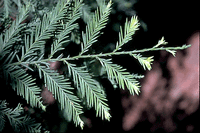A highlight of my undergraduate research experiences was working with Dr. Harold A. Mooney on an Honors Thesis entitled "Heterogeneous leaf form in redwood". By locating recently-fallen redwood (Sequoia sempervirens) trees in their natural habitat, I collected leaves along the boles of three trees from heights of 17 m up to 77 m above the ground. I measured leaf morphological and anatomical characteristics as they changed with height above ground and with distance from the bole.
 |
This tip of a redwood branch shows the typical morphology of shade leaves (large and flat) |
In order to gain insights into the plasticity in leaf morphology across this gradient, I grew seedling redwood trees under varying conditions of drought and shade, the two primary factors that change from the base of trees to the tops. Leaf morphology and photosynthesis were shown to be responsive to both light and drought. The transition from flat, broad leaves to scale-like needles was seen as yielding an overall tree architecture that maximized growth in the productive, light-limiting coastal environments of California.
Sadly, I did this work before I realized the importance of publication - if you want a copy of this honors thesis, I can send it to you! I'm sure it still exists in the bowels of the Stanford Library somewhere!
Honors thesis: 1978. Heterogeneous leaf form in redwood: Distribution and function. Honors thesis. Department of Biological Sciences. Stanford University. 22 pp.